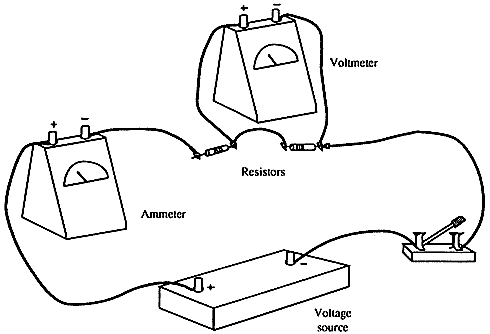 |
 |
|
|
|
|
Grades 9-12 Performance Task Description:Students will determine the power dissipated in the combination of two resistors connected in series to a 6 volt battery. This task assesses students' abilities to develop procedures for an investigation, develop a plan for recording and organizing observations and data, observe and collect data, plot an appropriate graph, make accurate calculations, and write a detailed conclusion. This task is designed to take students approximately 80 minutes to complete - 30 minutes for Part A and 50 minutes for Part B. Overall Task Content Area:
Specific Knowledge Areas:
Performance Expectations:
National Science Education Standards:12 A SI 1: Abilities necessary to do scientific
inquiry: Grades 9-12 1.3 Use technology and mathematics to improve investigations and communications. A variety of technologies, such as hand tools, measuring instruments, and calculators, should be an integral component of scientific investigations. The use of computers for the collection, analysis, and display of data is also a part of this standard. Mathematics plays an essential role in all aspects of an inquiry. For example, measurement is used for posing questions, formulas are used for developing explanations, and charts and graphs are used for communicating results. 1.4 Formulate and revise scientific explanations and models using logic and evidence. Student inquiries should culminate in formulating an explanation or model. Models should be physical, conceptual, and mathematical. In the process of answering the questions, the students should engage in discussions and arguments that result in the revision of their explanations. These discussions should be based on scientific knowledge, the use of logic, and evidence from their investigation. 12 B PS 4: Motions and forces: Grades
9-12 (Use the "hot" link on the PALS home page to check the full text of related National Science Education Standards, if desired.) National Council of Teachers of Mathematics:NO3: Compute fluently and make reasonable estimates:
MEAS1: Understand measurable
attributes of objects and the units, systems, and processes
of measurement: PS2: Solve problems that arise in mathematics and
in other contexts: COM4: Use the language of mathematics to express
mathematical ideas precisely: REP1: Create and use representations to organize,
record, and communicate mathematical ideas: REP3: Use representations to model and interpret
physical, social, and mathematical phenomena: General Instructions to the Teacher:This task is designed to take students approximately 80 minutes to complete. Students will be working individually during this exercise. Students should be ready to work as soon as the period begins. The materials should be set out at each lab station, if possible. A central supply area, if needed, should be easily accessible. All supplies should be clearly labeled. Materials for "Electric Circuits":At each station students will need:
Notes: If 20 ohm resistors or 6 volt batteries are not available, choose resistors to match your power supply, or use two lamps.
Advance Preparation:None Safety:
Extensions/Modifications:None
|

